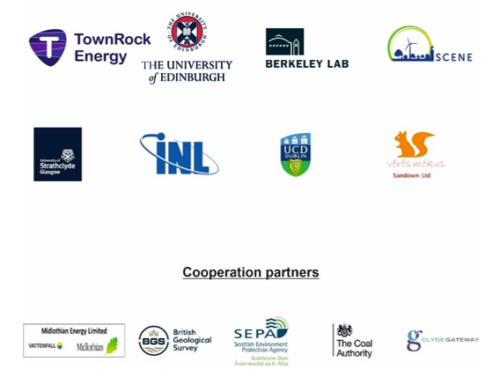Galleries to Calories is a research collaboration involving industry, academic and national research partners from Scotland, USA and Ireland, all contributing something different to the project.
TownRock Energy is the overall project industry lead, and is an an award-winning geothermal energy company based in Edinburgh. TRE are market leaders in the delivery of techno-economic assessments of geothermal energy resources and engineered geothermal system for private, public and third sector clients across the UK.
The University of Edinburgh, School of GeoSciences, is the overall project academic lead. The UoE PI Professor Christopher McDermott has worked in industry and academia, holds two MSc level qualifications, a PhD and a German habilitation (2006) in Applied Geoscience and Hydro-Informatics. He has wide ranging coupled process modelling experience and experimental design experience, much specifically related to geothermal applications.
The University of Strathclyde is leading on Work Package 7 (WP7), looking at existing and new technologies for dynamic monitoring. Dr Stella Pytharouli’s research focuses on the development of monitoring strategies and the analysis of monitoring data acquired using passive seismic and aerial, terrestrial and satellite surveying technologies, aiming to help interpretation of surface and subsurface processes and assess the structural integrity of infrastructure.
Lawrence Berkeley National Laboratory, USA, is leading on the dynamic system (WP5) and is a key contributor to the techno-economic business development (WP8). The Berkeley Lab is a multiprogram science lab in the U.S. national laboratory system supported by the U.S. Department of Energy through its Office of Science, with over 4000 employees. It is managed by the University of California and is charged with conducting unclassified research across a wide range of scientific disciplines.
Idaho National Laboratory is a key contributor to the dynamic system (WP5) and the thermal resources assessment (WP6). Idaho National Laboratory is a multiprogram science lab in the US national laboratory system supported by the US Department of Energy through its Nuclear Energy R&D. INL has a staff of over 4,500 with annual operating budget of over $1 billion. INL’s mission is to discover, demonstrate, and secure innovative nuclear energy solutions, other clean energy options, and critical infrastructure.
University College Dublin (UCD) is leading on the dissemination and capacity building (WP9) and contributing to the environmental and geosciences site characterisation (WP2), the dynamic system (WP5) and the thermal resource assessment and sustainable management (WP6). UCD is Ireland’s largest university and leader for research funding. It is one of Europe’s leading research-intensive universities. The researchers involved in G2C at UCD are senior members of the Fault Analysis Group, which conducts basic and applied research on all aspects of faults and other types of fracture, in a variety of sectors including coal, geothermal, hydrogeology, minerals, petroleum and storage.
Our industry partners are:
Sandown Ltd, which provides legal research and engineering services in the geo, civil, hydro, enviro and mining sectors. Legal related services include research and advisory reporting for the EU funded HORIZON 2020 – WP 2014-2015 into the environmental footprint of shale gas development in the EU (as a member of the FracRisk consortia). Sandown is contributing to WP2, 3, 7 and 8.
Scene is a community renewable energy and local energy specialist. Scene is both a practitioner and research organisation, and one of very few British organisations that has made a purposeful effort to provide market research and engagement services, whilst backing up this research expertise with a tangible development portfolio and associated expertise. They are leading on WP4 environmental, social and economic baseline and future sustainability.
We are also delighted to have as our cooperation partners: The British Geological Survey; Clyde Gateway; The Coal Authority; Edinburgh Parallel Computing Centre; Midlothian Energy; and Scottish Environmental Protection Agency.


Leave a Reply